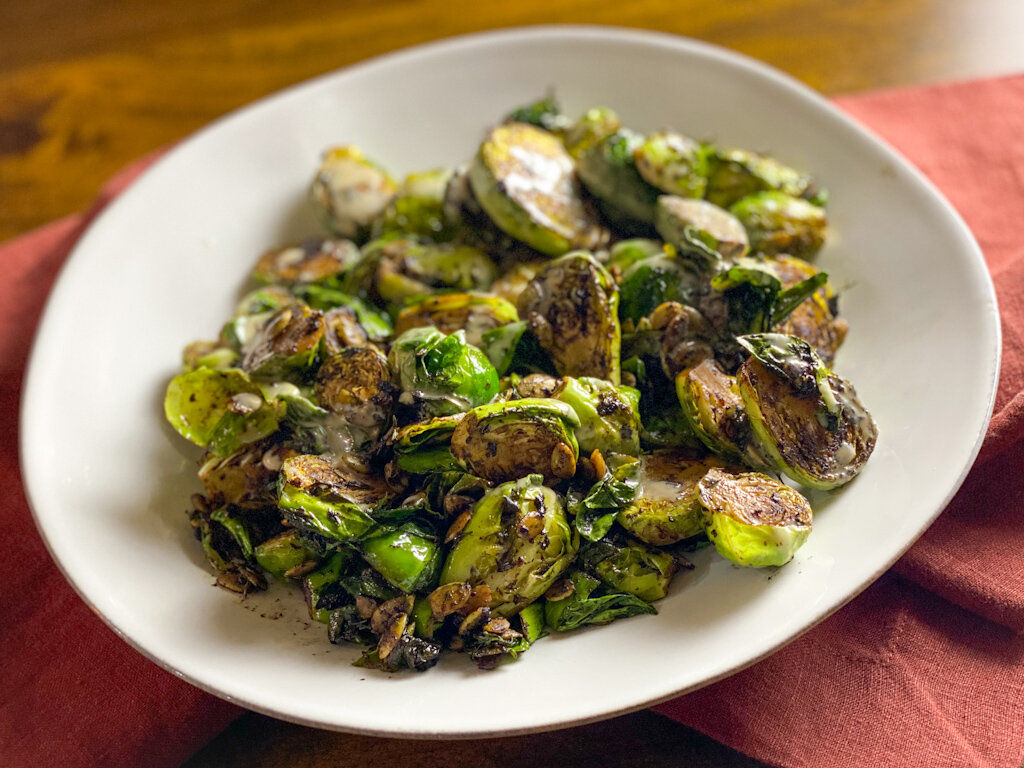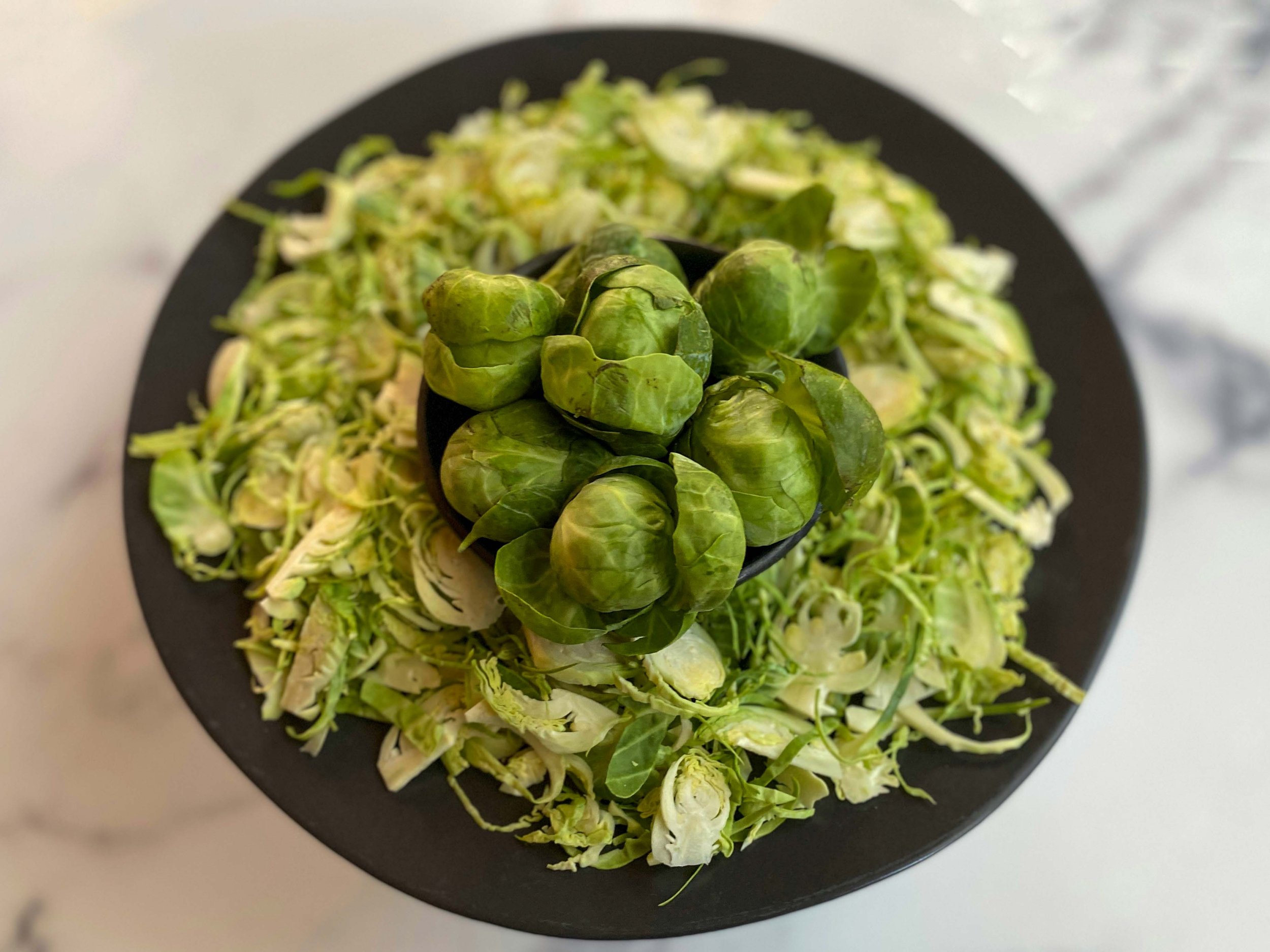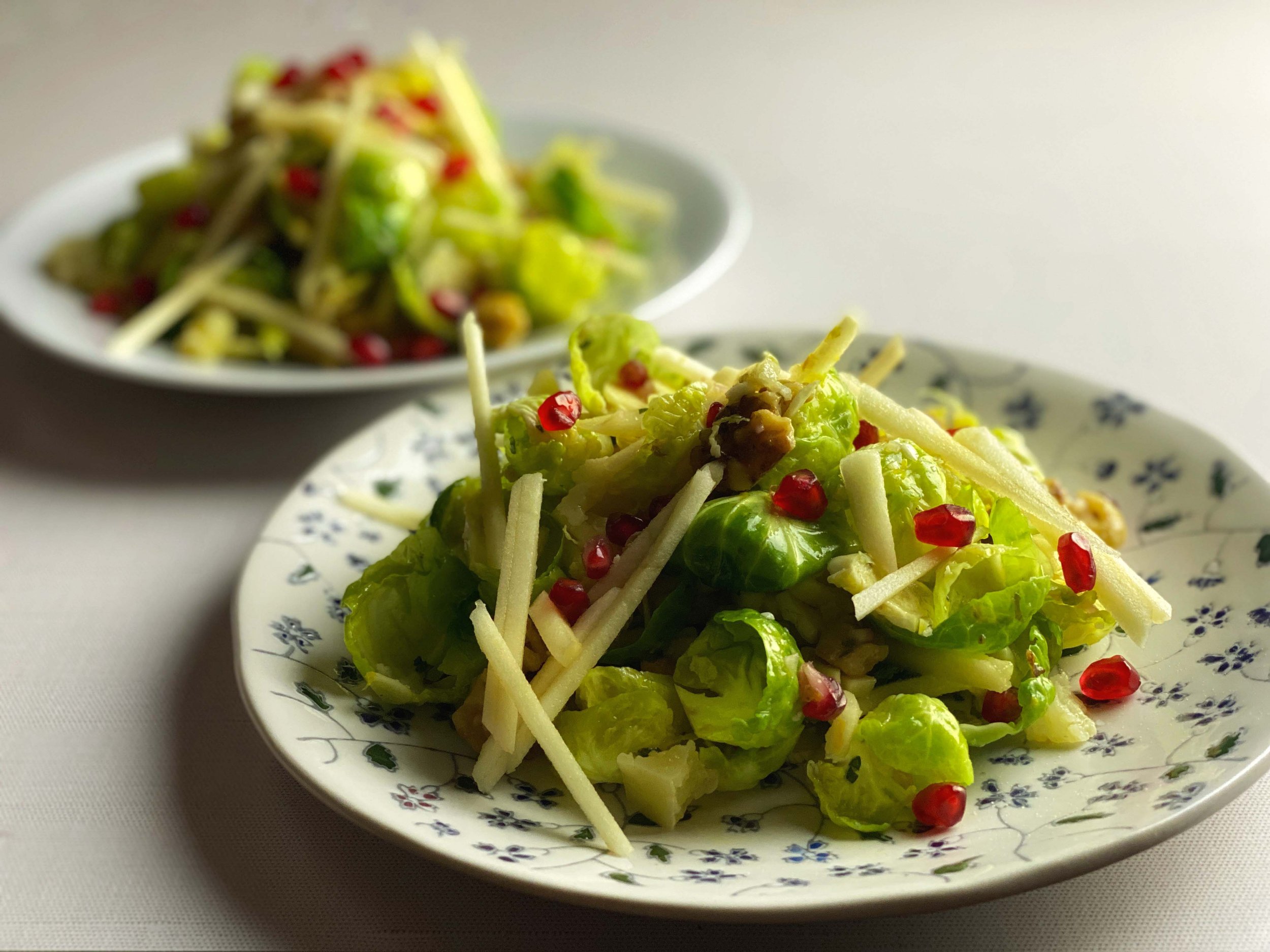By Leslie Brenner
[Updated Dec. 22, 2022]
“Brussels sprouts are never going to win any popularity contests.”
That was the dire prediction, printed in The Los Angeles Times in 1999, of its then-Food Editor, Russ Parsons. If you happen to be a Gen Zer, it may shock you to learn that Brussels sprouts were not always the most glamorous members of the vegetable kingdom. Parsons continued:
“They’re the weak member of the vegetable pack, the one everyone likes to pick on. Brussels sprouts are weird-looking, like miniature cabbages. Maybe that’s why they’re usually shoved away in some dark corner of the produce market. Unlike broccoli, which is also weird-looking but seems to be in your face every time you turn around, they’ll never gain acceptance merely through familiarity.”
Two decades later, Brussels sprouts — those ping-pong-ball-sized upstarts of the Brassica oleracea family — are the darlings of, well, just about every omnivore in America. They’re so popular and menu-ubiquitous that no one under a certain age would probably even wonder whether they were ever not a thing.
What’s the explanation for the once lowly vegetable’s meteoric rise?
Most brassica-watchers would point to David Chang, the chef who founded the Momofuku empire that began in New York City in 2004 with the opening of the first Momofuku Noodle Bar. On its menu were Brussels sprouts that Chang pan-roasted with bacon then tossed with puréed kimchi. “Every single table ordered them,” he told GQ magazine in 2009. “It was ridiculous.”
“Cook the shit out of them; just don’t turn them to charcoal.”
He also told the magazine the secret to making them not just palatable, but crave-able: “Cook the shit out of them; just don’t turn them to charcoal.”
Brussels sprouts also made a splash, in a different form, a few years later at his second place, Momofuku Saam Bar. There they were fried and tossed with pickled Thai and Korean chiles, fish sauce, garlic and mint, and topped with fried Rice Krispies. Recipes for both were included in Chang and Peter Meehan’s Momofuku: A Cookbook, published in 2009.
Three years later, Brussels sprouts’ rise to culinary glory was achieved; in fact, it looked like a revolution. “Brussels sprouts’ transformation from maligned cafeteria gross-out fare to foodie luminary is complete,” is the way a Slate article by L.V. Anderson put it in 2012. “Trendy New York restaurants gussy them up with pig fat and sell them by the tiny $8 plateful; David Chang’s Brussels sprouts at New York’s Momofuku were so popular he had to take them off the menu for his cooks’ well-being.”
I remember the moment well: I had moved from Los Angeles, where we’d been enjoying Brussels sprouts for years, to Dallas, where they were just then hitting every restaurant in town — usually roasted with a dose of sugar and a good deal of bacon.
Though Chang certainly did more than anyone to popularize the B-sprout, by no means was he the first to fall in love with them.
From Brussels and Burgundy to Birds Eye and bistros: a quickie B-sprout history
According to the late British cookbook author and food historian Jane Grigson, who wrote more than anything else I could turn up about the history of Brussels sprouts, the vegetable’s past is somewhat mysterious. “It seems they were being grown around Brussels in the Middle Ages; market regulations of 1213 mention them,” she wrote in Jane Grigson’s Vegetable Book, published in 1978. She continued:
“They were ordered for two wedding feasts of the Burgundian court at Lille in the 15th century . . . . Then silence. They do not seem to have caught on in Burgundy . . . Nor did they appear in French and English gardens until the end of the 18th century.”
Across the pond in America, Thomas Jefferson planted them in his garden at Monticello in 1812.
In the intervening century and a half, not much to report. When I was growing up in the 1960s and 70s in Southern California, Brussels sprouts made frequent appearances on our dinner table, having been pulled from a Birds Eye box in the freezer and boiled whole. Most people I knew did not enjoy them; I was an outlier, who loved their little tiny-cabbage-ness.
My husband Thierry tells me they were not so reviled and stigmatized when he was a child in France. Perhaps they were treated with more care there. A spin through Julia Child’s 1961 classic Mastering the Art of French Cooking, Volume I, offers no fewer than eight recipes: braised in butter; braised with chestnuts; browned with cheese; chopped, with cream; creamed; custard mold; and gratinéed with cheese sauce. Volume II, published nine years later, didn’t include a single B-sprout recipe.
They certainly were popular in England. “The great success of Brussels sprouts in this country has been in modern times,” wrote Grigson. “We serve them now with beef, game, poultry, and especially with the Christmas turkey, when they are often embellished with chestnuts. She went on to offer nine ways to cook them.
Could they have been a thing early on at Alice Waters’ Chez Panisse, which opened in Berkeley, California, in 1971? They make no appearance in the Chez Panisse Menu Cookbook, published in 1982 (the Washington Post, incidentally, has called it one of the earliest restaurant cookbooks). There is, however, a fabulous recipe in the book that followed eight years later — Chez Panisse Cooking. In fact it’s the recipe that made me fall hard for the vegetable: Brussels Sprouts Leaves Cooked with Bacon and Mirepoix. Yes, bacon!
Brussels Sprouts Cooked with Bacon and Mirepoix, prepared from a recipe in ‘Chez Panisse Cooking’
That recipe has been a fixture on my Thanksgiving table every year since.
The bacon in the light and elegant Chez Panisse dish comes in the form of pancetta, which gets diced and sweated with the mirepoix (diced carrot, onion and celery) before adding Brussels sprouts leaves which get sort of steamed; a hit of white wine vinegar at the end gives beautiful balance.
A pre-Chang boost
Russ Parsons — the California cook who doubted their popularity potential — was actually an influential Brussels sprouts cheerleader a few years before Momofuku’s Chang started charring them and umamifying the bejeezus out of them. Parsons gave his legions of L.A. readers a full chemical explanation for why the hapless veg fell into such disrepute: People overcooked them, producing hydrogen sulfide — a sulfurous stink, and they turned a sickly color thanks to a transformation of their chlorophyll. “To get around it,” he suggested, “try treating Brussels sprouts with the respect they deserve. It takes a little more care in preparation and a little more attention to detail, but the payoff will be amazing. . . . "
Following instructions on how to prep and steam or blanch them, he added:
“What you do with them after that is up to you, of course. They’re delicious simply dressed with olive oil and a little chopped garlic. But they also are assertive enough to hold their own in the company of more emphatic flavors. I really like to pair Brussels sprouts with smoky things like bacon. And when you’re using bacon, it’s usually a good idea to add something sharp, like vinegar, to cut the fat.
Look at it as making a he-man out of a scorned vegetable. Call it the Brussels sprout make-over.”
Bacon and acid: That’s the Momofuku B-sprout blueprint right there. The fact that Chang pushed everything so far — the char, the bacon, the exuberant flavors of chiles and fish sauce — made his two dishes prime for borrowing by chefs all around the country. And there you have it: the cementing of Brussels Sprouts primacy.
Ottolenghi: a bit late to the sprout
Surprisingly, London’s superstar vegetable-loving chef and world-dominating cookbook author Yotam Ottolenghi was somewhat late to the Brussels sprout game, which is odd considering the brassica’s longtime popularity in Britain. There’s not a single B-sprout recipe in Ottolenghi’s first, second or third books (published in 2008, 2010 and 2012). Finally, in Plenty More (2014), he offers instructions for Brussels Sprouts Risotto; Brussels Sprouts with Caramelized Garlic and Lemon Peel; and Roasted Brussels Sprouts with Pomelo and Star Anise.
I went wild for the Brussels Sprouts with Browned Butter and Black Garlic in his 2018 book Ottolenghi Simple, largely thanks to the black garlic’s serious umami and the creamy earthiness of tahini, all balanced by zingy lemon and herbs. So have our readers: Our adaptation was Cooks Without Borders’ fourth-most clicked on recipe in the last year.
Insalata di Cavotelli (Brussels sprouts salad) prepared from a recipe in the new cookbook from Via Carota
Now trending: B-sprouts salads
This season, Brussels sprouts are trending raw: They’re featured in two of this fall’s most exciting new cookbooks. The first, shown above, is from Via Carota — the new volume from Jody Williams and Rita Sodi’s beloved New York City restaurant, which is Cooks Without Borders first-ever Cookbook of the Year. Tossed with Via Carota’s signature dressing, plus julienned apple, pomegranate seeds and crumbly aged cheese, it’s spectacular.
The second is from Tanya Holland’s California Soul, in which the star of “Tanya’s Kitchen Table” on the Oprah Winfrey Network presents a recipe for Shaved Brussels Sprouts Salad with Warm Bacon Dressing. (I know, right?!) It’s one of our Best New Cookbooks of 2022.
And finally, here is a super-easy roasted number studded with pancetta. No thin-slicing or leaf removal necessary!
If you like this story, we think you’ll enjoy:
READ: Holy minestrone — Italy’s favorite soup deserves way more respect
READ: How to make your own Tunisian-style harissa — and why you’ll be thrilled you did
READ: Moussaka, a dish with a curious history, gets a magnificent (and long overdue!) makeover
READ: Taiwanese and Taiwanese American culinary traditions shine in three exciting cookbooks





